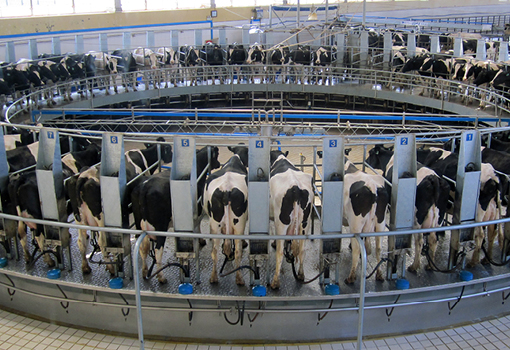As a member of our industry, you are facing several challenges in managing the transition phase and early lactation of dairy cows. When these challenges are not managed well, they will impact you and your business. What are these challenges, and how can we turn these challenges into opportunities for an even better transition phase and early lactation management? We asked Dr. Fabio Lima, Assistant Professor of Livestock Health & Theriogenology School of Veterinary
Medicine, University of California. He focuses on improving the health, performance and fertility of dairy cows. His work includes studies investigating nutritional strategies to improve the health, immunity, and reproduction of dairy cows during the transition period.

During these phases, dairy cows face several challenges such as final fetal development, colostrum production, immunological stress, parturition, increased exposure to pathogens and adaptation to lactation. They are under a negative energy balance and are in a catabolic state needing to breakdown mainly adipose tissue and to some degree muscle to match the energy requirement for their vital functions and lactation. Therefore, triglycerides stored in adipose tissue will be broken down into non-esterified fatty acids (NEFA) that will be transported to the liver. In the liver, NEFA can fully be oxidized to produce ATP and energy for dairy cows, but the second strategy of the liver to deal with NEFA is re-esterification into triglycerides so it can be transported to other tissues as source of energy. If the degree of re-esterification is too high, cows develop a fatty liver. Another pathway for NEFA metabolization that increases, when first two pathways are depleted is ketogenesis, is the production of ketone bodies such as beta-hydroxybutyrate (BHB). The increase of BHB will lead to subclinical and clinical ketosis and will increase the odds for cows to develop other disorders such as metritis, displacement of the abomasum, mastitis, and endometritis.
The limiting step for the transportation of triglycerides accumulated in the liver to other tissues (such as the mammary gland), is the synthesis of very low lipoprotein density (VLDL). Ruminants evolved without needing to transport VLDL out of the liver. Therefore, dairy cows have a predisposition to be deficient in the synthesis of VLDL. Indeed, VLDL synthesis is highly dependent on the availability of phosphatidylcholine, which can be synthesized from choline and to a lesser extent (~6%) from the de novo synthesis (s-adenosylmethionine act as co-factor to convert phosphatidylethanolamine into phosphatidylcholine).
The body of evidence in the scientific literature suggests that dairy cows are deficient in Choline and Choline supplementation can alleviate fatty liver and oxidative stress in the liver.
Unfortunately, feeding Choline either as Choline chloride or through feed ingredients that are rich in Choline such as barley, soybean meal, or cottonseed meal does not seem sufficient because more than 80% of the Choline will be degraded by microbes in the rumen. Therefore, to minimize Choline deficiency in dairy is by feeding rumen-protected forms of Choline.
Improvement of dry matter intake is essential to reduce the intensity of negative energy balance and, consequently, the associated metabolic disorders and immunological stress that are detrimental to dairy cows' health, productivity, and fertility.
Rumen-protected Choline can improve this dry matter intake. Two recent meta-analyses revealed that pre- and postpartum dry matter intake increased in cows fed with rumen-protected Choline.
Most studies have shown that supplementation of rumen-protected Choline leads to an increase in milk production. Two recent meta-analyses studies that analyze the data, the combined data of more than 20 studies revealed that on average feeding RPC would lead to 1-2 kg more milk per day. Few other studies report that the increases in milk production will go beyond the feeding period. In those studies, rumen-protected Choline was fed 21 days pre- and postpartum, but increases in milk production last up to 15 weeks postpartum.
The return over investment (ROI) in dairy cows will come from a combination of reduced health disorders, reduced culling, increased milk production early in lactation that leads to a legacy effect on lactation, and better reproductive performance. I built an algorithm that integrates the variables listed above from the results of different meta-analyses of rumen-protected Choline studies with few more assumptions to estimate ROI. Depending upon rumen Choline price, dose, and duration of feeding, the return of investment varied from 4 to 9 times, which is the substantial return.

When selecting a rumen-protected Choline, you must realize that these products have different rumen stability and intestinal absorption. This influences the bioavailability of rumen-protected Choline and the expected results. Therefore, consumers need to look for products that have sound scientific support for bioavailability and findings in animal trials.
Rumen protected Choline is one of the major methyl donors and potentially could have an impact on DNA methylation patterns and the epigenome of developing embryos and calves. Therefore, there is a need to investigate if feeding rumen-protected Choline for cows during the period of artificial insemination and early embryonic development might help to reprogram calves for improved immunity, health, and development.
A leaky gut is a challenge that only gained attention for a few years. Recent studies show that cows in stressful conditions, heat stress, and the transition period, have a reduced feed intake and are therefore at higher risk of developing issues with gastrointestinal integrity (leaky gut). These cows are more likely to have endotoxin and bacteria escaping through the intestines into the bloodstream and causing, among other issues, chronic stimulation of the immune system and problems with energy metabolism. In rats, supplementation with Choline has shown to improve the integrity of the intestines. Therefore, studies with rumen-protected Choline are needed to test the hypothesis that its supplementation might improve intestinal integrity.
Rumen-protected Choline will play a major role in the dairy cow nutrition in the upcoming years.
© Kemin Industries, Inc. and its group of companies 2025 all rights reserved. ® ™ Trademarks of Kemin Industries, Inc., USA
Certain statements may not be applicable in all geographical regions. Product labeling and associated claims may differ based upon government requirements.